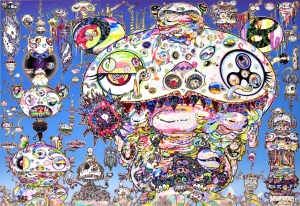
In the Land of the Dead, Stepping on the Tail of a Rainbow
About This Artwork
Takashi Murakami’s massive eighty-two-foot-long painting, In the Land of the Dead, Stepping on the Tail of a Rainbow, is informed by 18th century painters Soga Shohaku and Ito Jakuchu. Shohaku believed in reaching for new and alternative truths in picture making by imitating existing forms or styles and imbuing them with new essence. Murakami follows this belief, here using figures and motifs directly taken from Shohaku’s painting Gunsenzu, or Immortals (1764), itself an imitation of an older version, which depicts Taoist hermits with magical powers. On the far left, a hermit in blue riding a dragon; the hermit on the far right who holds a baby; and the potbellied hermit leaning on a frog are but a few motifs Murakami appropriates from Immortals. However, the painting is unmistakably Murakami’s, reminiscent of contemporary Japanese cartooning and culture though rooted century’s old traditions.












